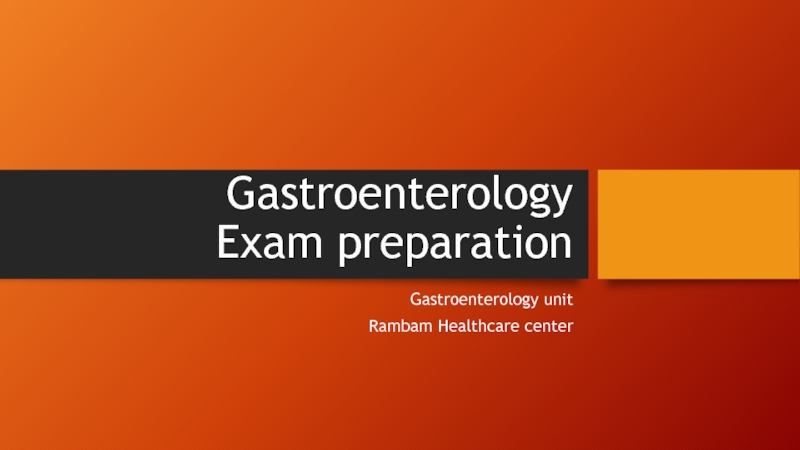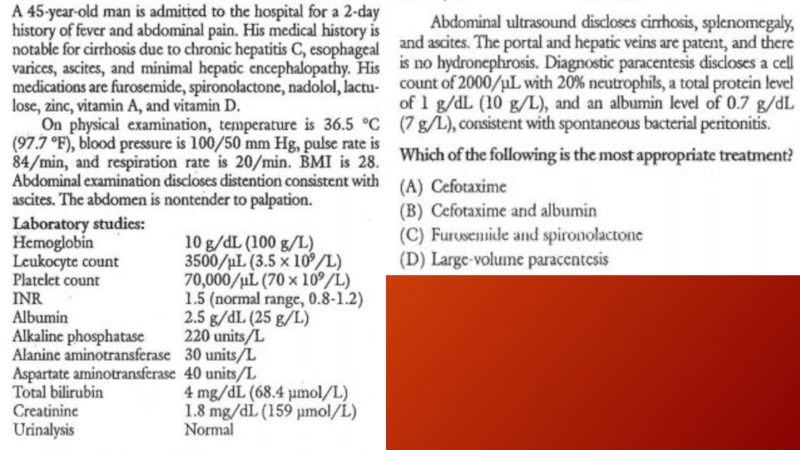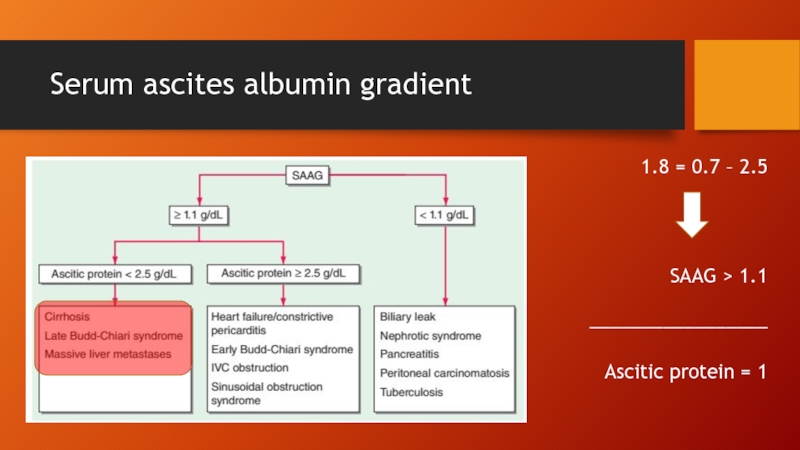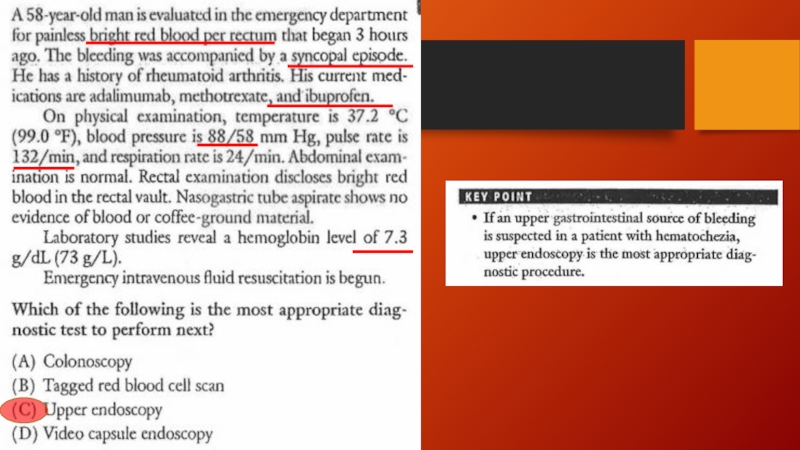- Главная
- Разное
- Дизайн
- Бизнес и предпринимательство
- Аналитика
- Образование
- Развлечения
- Красота и здоровье
- Финансы
- Государство
- Путешествия
- Спорт
- Недвижимость
- Армия
- Графика
- Культурология
- Еда и кулинария
- Лингвистика
- Английский язык
- Астрономия
- Алгебра
- Биология
- География
- Детские презентации
- Информатика
- История
- Литература
- Маркетинг
- Математика
- Медицина
- Менеджмент
- Музыка
- МХК
- Немецкий язык
- ОБЖ
- Обществознание
- Окружающий мир
- Педагогика
- Русский язык
- Технология
- Физика
- Философия
- Химия
- Шаблоны, картинки для презентаций
- Экология
- Экономика
- Юриспруденция
Gastroenterology. Exam preparation презентация
Содержание
- 1. Gastroenterology. Exam preparation
- 3. Serum ascites albumin gradient 2.5 – 0.7
- 4. Spontaneous bacterial peritonitis common and severe complication
- 5. Spontaneous bacterial peritonitis (cont.) Patients with ascites
- 6. Hepatorenal syndrome form of functional renal failure
- 9. Irritable bowel syndrome
- 10. Diagnosis No specific laboratory or imaging test
- 13. Melena – UGIB (as little as
- 20. Endoscopic therapy
- 26. Dyspepsia in patient younger than 50
- 35. Good luck!
Слайд 3Serum ascites albumin gradient
2.5 – 0.7 = 1.8
SAAG > 1.1
_________________
Ascitic protein
= 1
Слайд 4Spontaneous bacterial peritonitis
common and severe complication of ascites characterized by spontaneous
infection of the ascitic fluid without an intraabdominal source.
In patients with cirrhosis and ascites severe enough for hospitalization, SBP can occur in up to 30% of individuals and can have a 25% in-hospital mortality rate.
Bacterial translocation is the presumed mechanism for development of SBP, with gut flora traversing the intestine into mesenteric lymph nodes, leading to bacteremia and seeding of the ascitic fluid
The most common organisms are Escherichia coli and other gut bacteria (also enterococci, Strep viridans, Staph aureus…)
The diagnosis of SBP is made when the fluid sample has an absolute neutrophil count >250/μL
In patients with cirrhosis and ascites severe enough for hospitalization, SBP can occur in up to 30% of individuals and can have a 25% in-hospital mortality rate.
Bacterial translocation is the presumed mechanism for development of SBP, with gut flora traversing the intestine into mesenteric lymph nodes, leading to bacteremia and seeding of the ascitic fluid
The most common organisms are Escherichia coli and other gut bacteria (also enterococci, Strep viridans, Staph aureus…)
The diagnosis of SBP is made when the fluid sample has an absolute neutrophil count >250/μL
Слайд 5Spontaneous bacterial peritonitis (cont.)
Patients with ascites may present with fever, altered
mental status, elevated white blood cell count, and abdominal pain or discomfort, or they may present without any of these features.
Therefore, it is necessary to have a high degree of clinical suspicion, and peritoneal taps are important for making the diagnosis.
Treatment is with a second-generation cephalosporin, with cefotaxime being the most commonly used antibiotic.
In patients with variceal hemorrhage, the frequency of SBP is significantly increased, and prophylaxis against SBP is recommended when a patient presents with upper GI bleeding.
Therefore, it is necessary to have a high degree of clinical suspicion, and peritoneal taps are important for making the diagnosis.
Treatment is with a second-generation cephalosporin, with cefotaxime being the most commonly used antibiotic.
In patients with variceal hemorrhage, the frequency of SBP is significantly increased, and prophylaxis against SBP is recommended when a patient presents with upper GI bleeding.
Слайд 6Hepatorenal syndrome
form of functional renal failure without renal pathology that occurs
in about 10% of patients with advanced cirrhosis or acute liver failure
The diagnosis is made usually in the presence of a large amount of ascites in patients who have a stepwise progressive increase in creatinine
Type 1 HRS Type 2 HRS
Currently, patients are treated with α-agonist (glypressin) / octreotide and intravenous albumin.
The best therapy for HRS is liver transplantation
The diagnosis is made usually in the presence of a large amount of ascites in patients who have a stepwise progressive increase in creatinine
Type 1 HRS Type 2 HRS
Currently, patients are treated with α-agonist (glypressin) / octreotide and intravenous albumin.
The best therapy for HRS is liver transplantation
Слайд 10Diagnosis
No specific laboratory or imaging test can be performed to diagnose
irritable bowel syndrome.
Diagnosis involves excluding conditions that produce IBS-like symptoms, and then following a procedure to categorize the patient's symptoms.
Ruling out parasitic infections, lactose intolerance, small intestinal bacterial overgrowth, and celiac disease is recommended for all patients before a diagnosis of irritable bowel syndrome is made.
In patients over 50 years old, they are recommended to undergo a screening colonoscopy
Diagnosis involves excluding conditions that produce IBS-like symptoms, and then following a procedure to categorize the patient's symptoms.
Ruling out parasitic infections, lactose intolerance, small intestinal bacterial overgrowth, and celiac disease is recommended for all patients before a diagnosis of irritable bowel syndrome is made.
In patients over 50 years old, they are recommended to undergo a screening colonoscopy
Слайд 13
Melena – UGIB (as little as 150-200 ml of blood loss)
Hematemesis
– ongoing UGIB
Hematochezia – LGIB or brisk ongoing UGIB with at least 1000 ml blood loss
NG tube placement misses up to 15% of actively bleeding lesions
Hematochezia – LGIB or brisk ongoing UGIB with at least 1000 ml blood loss
NG tube placement misses up to 15% of actively bleeding lesions
Слайд 26
Dyspepsia in patient younger than 50 yo w/o alarm features
Anemia
Dysphagia
Odynophagia
Weight loss
Vomiting
FH
of UGI malignancy
PH of PUD, gastric surgery or GI malignancy
Abdominal mass / LAD on exam
Test for H.pylori
(+) (-)
Eradication PPI trial
PH of PUD, gastric surgery or GI malignancy
Abdominal mass / LAD on exam
Test for H.pylori
(+) (-)
Eradication PPI trial








































